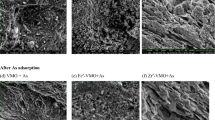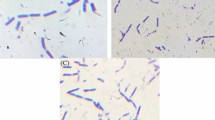Abstract
When low-cost adsorbents are being used to remove contaminant ions (e.g. arsenate, vanadate, and molybdate) from wastewater, competitive adsorption/desorption are central processes determining their removal efficiency. Competitive adsorption of As, V, and Mo was investigated using equimolar oxyanion concentrations in single, binary, and tertiary combinations in adsorption isotherm and pH envelope studies while desorption of previously adsorbed oxyanions was examined in solutions containing single and binary oxyanion combinations. The low-cost adsorbent materials used were alum water treatment sludge (amorphous hydroxy-Al) and bauxite ore (crystalline Al oxides). Adsorption isotherm and pH envelope studies showed that Mo had only a small effect in decreasing adsorption of As and V but V and As had substantial and similar effects in reducing adsorption of the other. As had a greater effect than V in reducing adsorption of Mo and it was concluded that the affinity of oxyanions for the surfaces of water treatment sludge and bauxite followed the order As > V >> Mo. In 0.3 M NaCl electrolyte, desorption of previously adsorbed oxyanions amounted to 0.3–3.4% for V and As, and 11–20% for Mo. As had approximately four times greater effect than Mo in increasing desorption of V while V had about three times the effect of Mo in increasing desorption of As. Thus, the order of oxyanions in inducing desorption of the other oxyanions (i.e. As on V and As) was the same as that for adsorption selectivity: As > V >> Mo. Water treatment sludge was a more effective adsorbent than bauxite because it had a greater adsorption capacity for all three anions and, in addition, they were held more strongly so desorption in the background electrolyte was proportionately less. It was concluded that at similar molar concentrations, arsenate would tend to reduce adsorption of vanadate as well as displace vanadate already held on adsorbent surfaces while both anions will compete effectively with molybdate. The limiting factor for simultaneous removal of As, V, and Mo from multielement solutions by adsorption will therefore be the removal of Mo.




Similar content being viewed by others
References
Adegoke HI, Adekola A, Fatoki OS, Ximba BJ (2013) Sorptive interaction of oxyanions with iron oxides: a review. Pol J Environ Stud 22:7–24
Apak R (2002) Adsorption of heavy metal ions on soil surfaces and similar substances. In: Hubbard AT (ed) Encyclopedia of surface and colloid science. CRC Press, Boca Raton, pp 385–417
Ardon M, Pernick A (1973) Molybdenum(IV) in aqueous solutions. J Am Chem Soc 95:6871–6872
Balistrieri LS, Chao TT (1987) Selenium adsorption by geothite. Soil Sci Soc Am J 51:1145–1151
Blackmore DPT, Ellis J, Riley PJ (1996) Treatment of a vanadium-containing effluent by adsorption/coprecipitation with iron oxyhydroxide. Water Res 30:2512–2516
Bowden JW, Posner AM, Quirk JP (1980) Adsorption and charging phenomena in variable charge soils. In: Theng BKG (ed) Soils of variable charge. New Zealand Society of Soil Science, Lower Hutt, pp 147–166
Brinza L, Benning LG, Statham PJ (2008) Adsorption studies of Mo and V onto ferrihydrite. Mineral Mag 72:385–388
CEM (1993) Microwave sample preparation note for banana leaves. Application Note AG 13. CEM Corporation, Mathews
Chiban M, Zerbet M, Carja G, Sinan F (2012) Application of low-cost adsorbents for arsenic removal: a review. J Environ Chem Ecotoxicol 4:91–102
Crans DC, Smee JJ, Gaidamauskas E, Yang L (2004) The chemistry and biochemistry of vanadium and the biological activities exerted by vanadium compounds. Chem Rev 36:95–102
Farrell J, Chaudhary BC (2013) Understanding arsenate reactions kinetics with ferric hydroxides. Environ Sci Technol 47:8342–8347
Goh K-H, Lim T-T, Banas A, Dong Z (2010) Sorption characteristics and mechanisms of oxyanions and oxyhalides having different molecular properties on Mg/Al layered double hydroxide nanoparticles. J Hazard Mater 179:818–827
Haynes R (2015) Use of industrial wastes as media in constructed wetlands and filter beds–prospects for removal of phosphate and metals from wastewater streams. Crit Rev Environ Sci Technol 45:1041–1103
Hua T, Haynes RJ (2016) Constructed wetlands: fundamental processes and mechanisms for heavy metal removal from wastewater streams. Int J Environ Eng 8:148–178
Hua T, Haynes RJ, Zhou Y-F, Boullemant A, Chandrawana I (2015) Potential for use of industrial materials as filter media for removal of Al, Mo, As, V and Ga from alkaline drainage in constructed wetlands—adsorption studies. Water Res 71:32–41
Jeong Y, Fan M, Van Leeuwen J, Belczyk JF (2007) Effect of competing solutes on arsenic(V) adsorption using iron and aluminium oxides. J Environ Sci 19:910–919
Manning BA, Goldberg S (1996) Modelling competitive adsorption of arsenate with phosphate and molybdate on oxide minerals. Soil Sci Soc Am J 60:121–131
Mayes WM, Batty LC, Younger PL, Jarvis AP, Koiv M, Vohla C, Mander U (2009) Wetland treatment at extremes of pH: a review. Sci Total Environ 407:3944–3957
McBride MB (2000) Chemisorption and precipitation reactions. In: Sumner ME (ed) Handbook of soil science. CRC Press, New York, pp B265–B302
Nagar R, Sarkar D, Makris KC, Datta R (2010) Effect of solution chemistry on arsenic sorption by Fe- and Al-based drinking-water residuals. Chemosphere 78:1028–1035
Nemerow NL (1978) Industrial water pollution: origins. In: Characteristics and treatment. Addison-Wesley, Reading
Peacock CL, Sherman DM (2004) Vanadium (V) adsorption onto goethite (alpha-FeOOH) at pH 1.5 to 12: a surface complexation model based on ab initio molecular geometrics and EXAFS spectroscopy. Geochim Cosmochim Acta 68:1723–1733
Prathop K, Namasivayam C (2010) Adsorption of vanadate (V) on Fe(III)/Cr(III) hydroxide waste. Environ Chem Lett 8:363–371
Rayment GE, Higginson FR (1992) Australian handbook of soil and water chemical methods. Inkata Press, Melbourne
Roy W, Hassett JJ, Griffith RA (1986a) Competitive interactions of phosphate and molybdate on arsenate adsorption. Soil Sci 142:187–245
Roy W, Hassett JJ, Griffin RA (1986b) Competitive coefficients for the adsorption of arsenate, molybdate and phosphate mixtures by soils. Soil Sci Soc Am J 50:1176–1182
Selim HM, Zhang H (2013) Modeling approaches of competitive sorption and transport of trace metals and metalloids: a review. J Environ Qual 42:640–653
Su T, Guan X, Tang Y, Gu G, Wang J (2010) Predicting competitive adsorption behaviour of major toxic anionic elements onto activated alumina: speciation-based approach. J Hazard Mater 176:466–472
Treybal RE (1980) Mass transfer operations, 3rd edn. McGraw-Hill, New York
Violante A, Pigna M (2008) Sorption-desorption process of metals and metalloids in soil environments. J Soil Sci Plant Nutr 8:95–108
Xie B, Fan M, Banerjee K, Van Leeuwen JH (2007) Modeling of arsenic(V) adsorption onto granular ferric hydroxide. J Am Water Works Assoc 99:92–102
Xu N, Braida W, Christodouatas C, Chen J (2013) A review of molybdenum adsorption in soils/bed sediments: speciation, mechanisms, and model applications. Soil Sediment Contam 22:912–929
Zachara JM, Ainsworth CC, Cowan CE, Resch CT (1989) Adsorption of chromate by subsurface soil horizons. Soil Sci Soc Am J 53:418–428
Author information
Authors and Affiliations
Corresponding author
Additional information
Responsible editor: Philippe Garrigues
Rights and permissions
About this article
Cite this article
Hua, T., Haynes, R.J. & Zhou, YF. Competitive adsorption and desorption of arsenate, vanadate, and molybdate onto the low-cost adsorbent materials alum water treatment sludge and bauxite. Environ Sci Pollut Res 25, 34053–34062 (2018). https://doi.org/10.1007/s11356-018-3301-7
Received:
Accepted:
Published:
Issue Date:
DOI: https://doi.org/10.1007/s11356-018-3301-7




